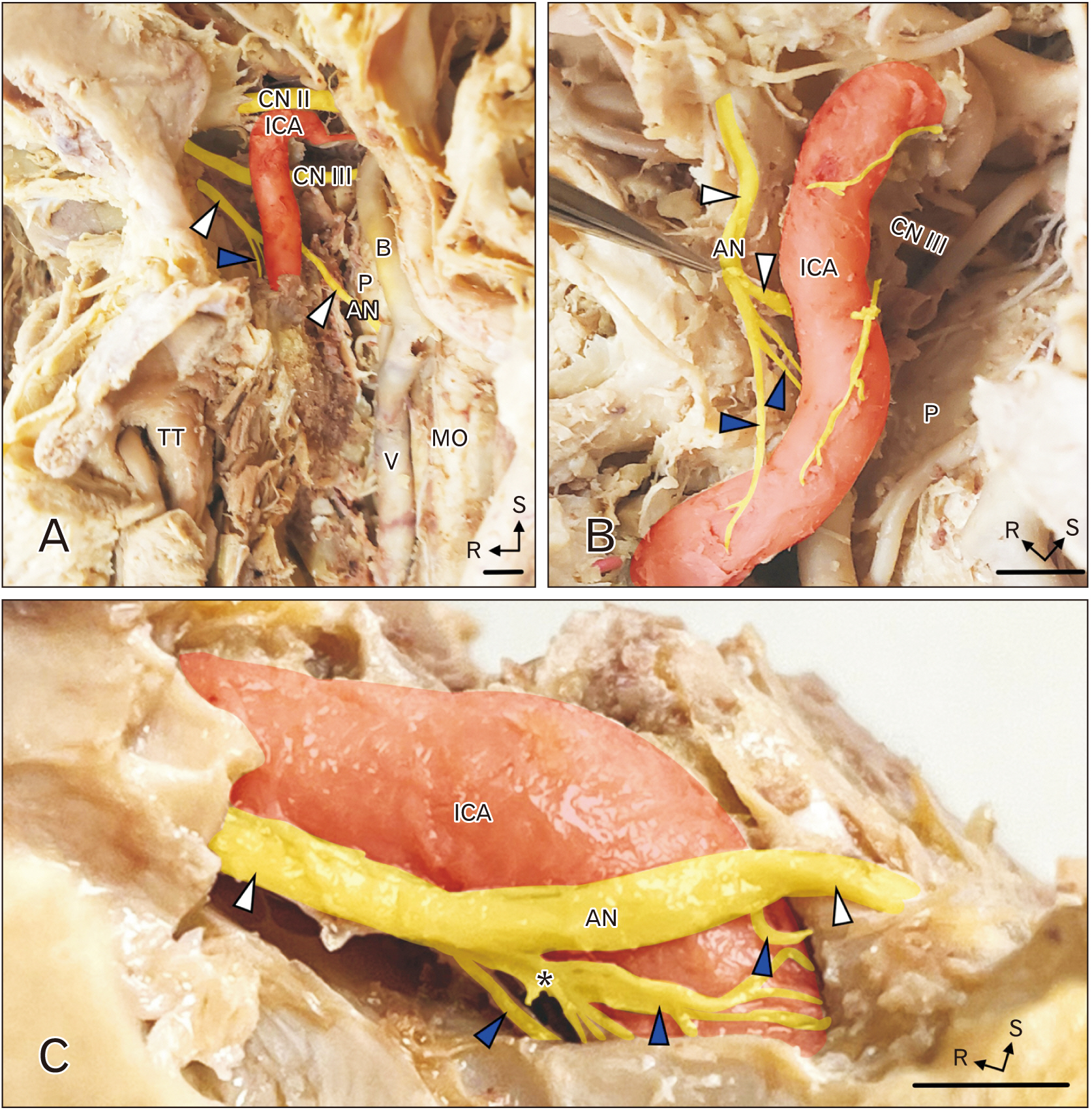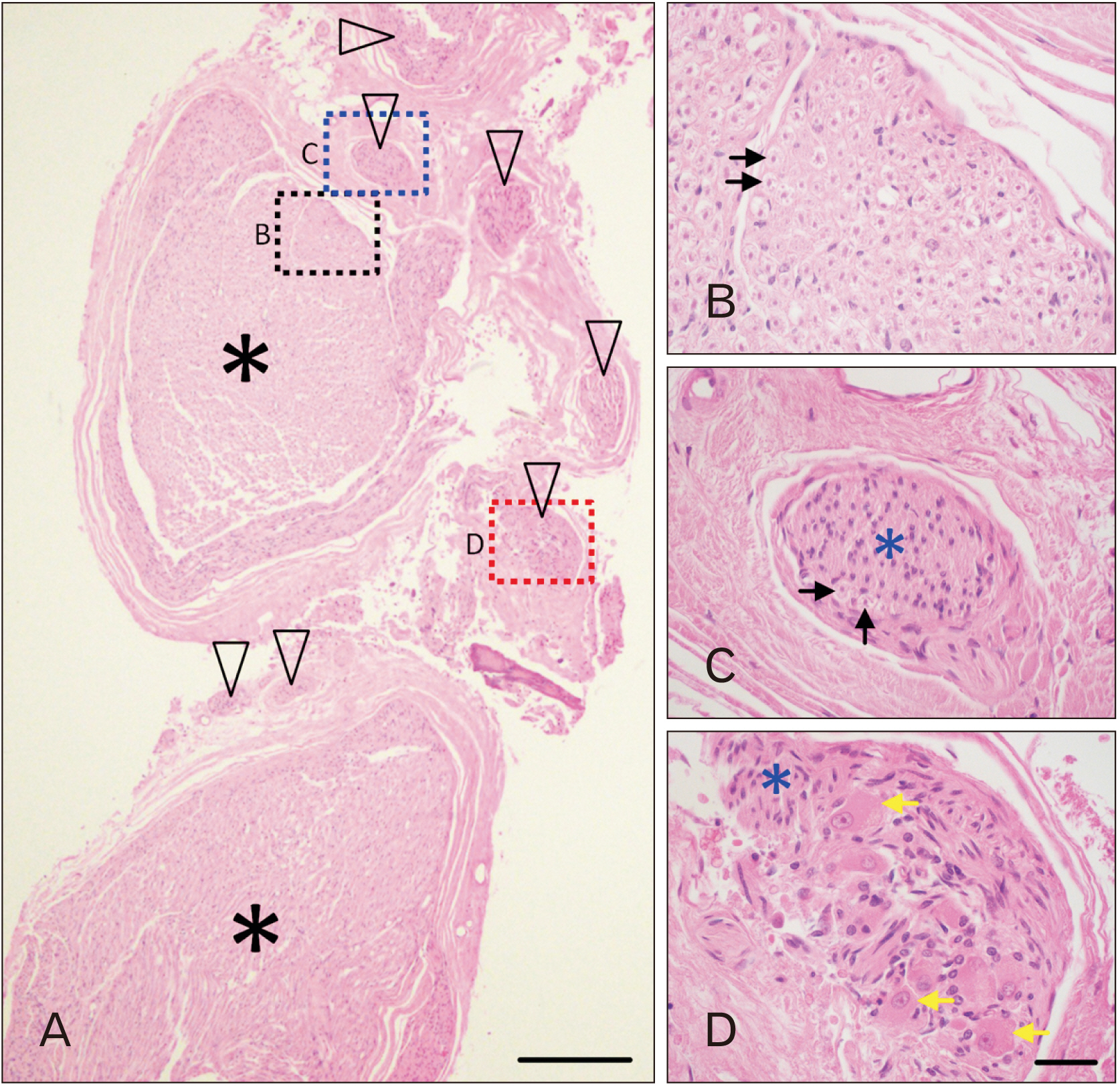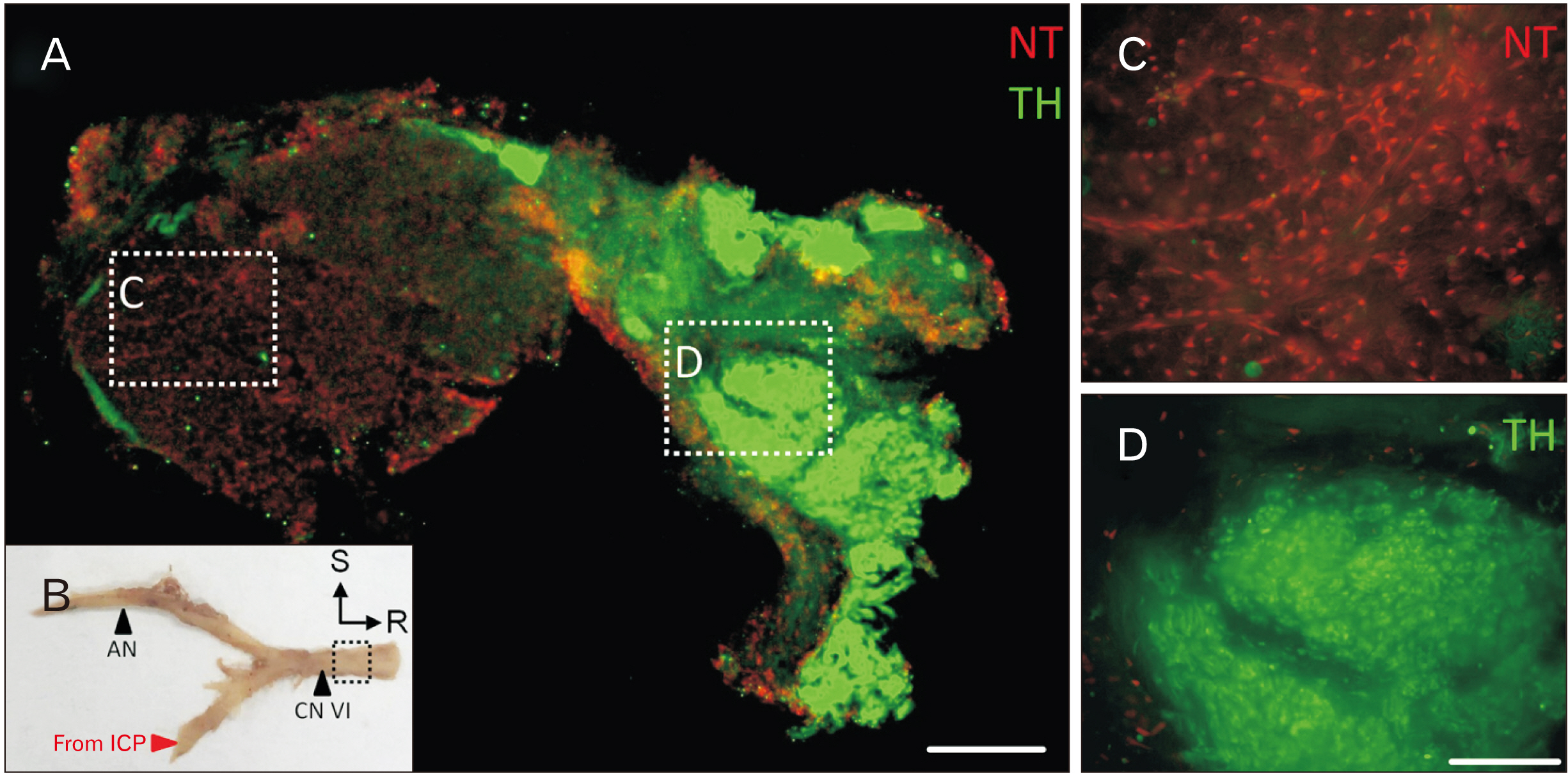Anat Cell Biol.
2023 Jun;56(2):271-275. 10.5115/acb.22.223.
Noradrenergic axons hitch hiking along the human abducens nerve
- Affiliations
-
- 1Department of Otolaryngology, Henry Ford Macomb Hospital, Detroit, MI, USA
- 2Department of Anatomy, Lake Erie College of Osteopathic Medicine, Erie, PA, USA
- KMID: 2544090
- DOI: http://doi.org/10.5115/acb.22.223
Abstract
- The abducens nerve (AN; cranial nerve VI) exits the brainstem at the inferior pontine sulcus, pierces the dura of the posterior cranial fossa, passes through the cavernous sinus in close contact to the internal carotid artery (ICA) and traverses the superior orbital fissure to reach the orbit to innervate the lateral rectus muscle. At its exit from the brainstem, the AN includes only axons from lower motor neurons in the abducens nucleus. However, as the AN crosses the ICA it receives a number of branches from the internal carotid sympathetic plexus. The arrangement, neurochemical profile and function of these sympathetic axons running along the AN remain unresolved. Herein, we use gross dissection and microscopic study of hematoxylin and eosin-stained sections and sections with tyrosine hydroxylase immunolabeling. Our results suggest the AN receives multiple bundles of unmyelinated axons that use norepinephrine as a neurotransmitter consistent with postganglionic sympathetic axons.
Figure
Reference
-
References
1. Standring S. 2016. Gray's anatomy: the anatomical basis of clinical practice. 41st ed. Elsevier;DOI: 10.1002/ca.22677.2. Cunningham DJ, Robinson A. 1931. Cunningham's text-book of anatomy. 6th ed. Oxford University Press;DOI: 10.5962/bhl.title.44024.3. Monro A. 1746. The anatomy of the human bones and nerves. 4th ed. Hamilton and Balfour;DOI: 10.5962/bhl.title.114861.4. Johnston JA, Parkinson D. 1974; Intracranial sympathetic pathways associated with the sixth cranial nerve. J Neurosurg. 40:236–43. DOI: 10.3171/jns.1974.40.2.0236. PMID: 4809122.
Article5. Quain J, Leidy J, Quain R, Sharpey W. 1849. Human anatomy. 1st ed. Vol 2:Lea and Blanchard;p. 343–4.6. Gray H, Pick TP, Howden R. 1901. Anatomy, descriptive and surgical. 15th ed. Lea Brothers;p. 802. DOI: 10.5962/bhl.title.31366.7. Plarr V, Power D, Spencer WG, Gask GE. 1930. Plarr's lives of the fellows of the Royal College of Surgeons of England. Vol 1:John Wright & Sons;p. 464.8. McGrath P. 1977; The cavernous sinus: an anatomical survey. Aust N Z J Surg. 47:601–13. DOI: 10.1111/j.1445-2197.1977.tb06591.x. PMID: 273404.
Article9. Parkinson D, Johnston J, Chaudhuri A. 1978; Sympathetic connections to the fifth and sixth cranial nerves. Anat Rec. 191:221–6. DOI: 10.1002/ar.1091910207. PMID: 666018.
Article10. Bleys RL, Janssen LM, Groen GJ. 2001; The lateral sellar nerve plexus and its connections in humans. J Neurosurg. 95:102–10. DOI: 10.3171/jns.2001.95.1.0102. PMID: 11453377.
Article11. Iwanaga J, Anand MK, Camacho A, Rodriguez F, Watson C, Caskey EL, Dumont AS, Tubbs RS. 2020; Surgical anatomy of the internal carotid plexus branches to the abducens nerve in the cavernous sinus. Clin Neurol Neurosurg. 191:105690. DOI: 10.1016/j.clineuro.2020.105690. PMID: 31982693.
Article12. Wysiadecki G, Radek M, Tubbs RS, Iwanaga J, Walocha J, Brzeziński P, Polguj M. 2021; Gross and micro-anatomical study of the cavernous segment of the abducens nerve and its relationships to internal carotid plexus: application to skull base surgery. Brain Sci. 11:649. DOI: 10.3390/brainsci11050649. PMID: 34065668. PMCID: PMC8156379. PMID: 7c47d66c3189421a831c3e0d82f96484.
Article13. Pickel VM, Joh TH, Reis DJ. 1975; Ultrastructural localization of tyrosine hydroxylase in noradrenergic neurons of brain. Proc Natl Acad Sci U S A. 72:659–63. DOI: 10.1073/pnas.72.2.659. PMID: 235760. PMCID: PMC432374.
Article14. Gellért A. 1934; Ganglia of the internal carotid plexus. J Anat. 68(Pt 3):318–22. PMID: 17104480. PMCID: PMC1249031.15. Carvalho VC. 1985; Nerve cells in the human cavernous sinus. Anat Anz. 159:29–32. PMID: 4096407.
- Full Text Links
- Actions
-
Cited
- CITED
-
- Close
- Share
- Similar articles
-
- A Case of Isolated Unilateral Abducens Nerve Palsy Caused by Clival Metastasis from Rectal Cancer
- Unilateral Abducens Nerve Palsy Associated with Ruptured Anterior Communicating Artery Aneurysm
- Cystic Abducens Schwannoma without Abducens Paresis : Possible Role of Cisternal Structures in Clinical Manifestation
- A Case of Traumatic Bilateral Abducens Nerve Palsy Associated with Skull Base Fracture
- A Patient Presented With Unilateral Abducens Nerve Palsy: A Variant Form of Guillain-Barre Syndrome With Anti-GT1a Antibody




